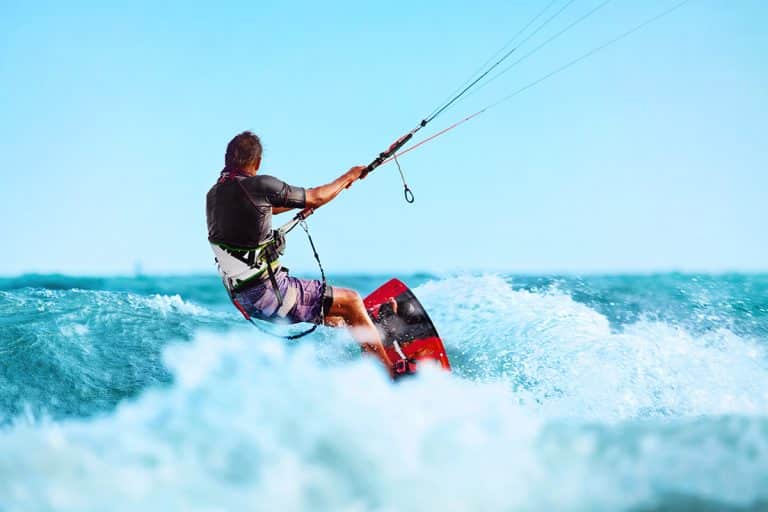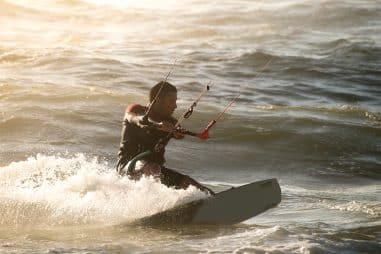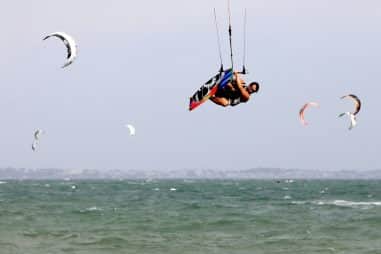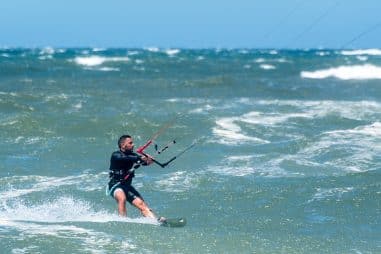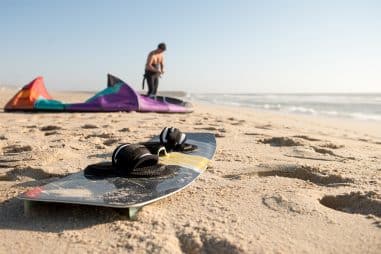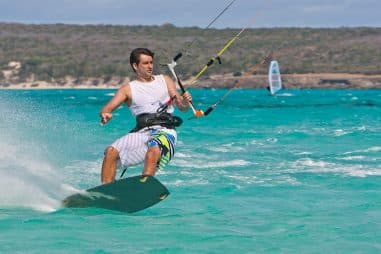Although kitesurfing seems tedious to learn the skill progression for kiteboarding is very speedy compared to other sports. These basic kitesurfing fundamentals such as waterstart, handle pass, kiteboarding pop, jump and raley could be also utilized to do advanced air tricks. Continue reading this guide because you will be leaving beginner level sooner than you expect.
How Do You Set Up a Kiteboarding Kite?
Learning to rig your kite is the first step to start kitesurfing. The process of setting up the kite is straightforward and very simple. Here’s a step-by-step guide in making your kite safe and secure to fly on the beach.
- Check the Wind: Observe and point out where the upwind and downwind are coming from. The wind direction determines the placement of your kite during setup.
- Unroll the kite: After determining the wind direction. Place your kite on your downwind side with the leading edge upwind and unfold the kite.
- Set-up the Pump: Before pumping secure the kite by attaching the leading edge to the pump to prevent it from blowing away.
- Attach pump hose: A kite has an inflate and deflate valve. Attach the hose to the inflate valve and make sure to close the deflate valve.
- Inflate the kite: Begin pumping your kite until it reaches the recommended pressure.
- Check kite pressure: Some pumps have a pressure gauge to know the air pressure. If your pump doesn’t have one you check by gripping the leading edge if it is underinflated.
- Secure the valve: Close the inflation valve tightly to prevent water and sand to accumulate inside the kite.
- Unroll the Lines: Kite lines connect you to your kite. Make sure the lines are straight and fully unrolled. Place it in a way that it won’t get tangled.
- Place the bar: Place the bar on the ground in the right orientation. Since we are setting up downwind, the bar should be flip over on the ‘opposite or wrong’ way.
- Sort the line: Separate the lines completely. Make sure the lines are not over each other as it may cause the kite to crash.
- Connect Lines to the Kite: Lines should be connected according to the kite’s manufacturer’s instructions.
If it is your first time setting up a kite it is advisable to check with your trainer or an experienced kiteboarder if the kite is fully secured. It is always an advantage to fly a well-set-up kite that gives you confidence and peace of mind while kitesurfing.
How Do You Control a Kiteboard Kite?
The control bar is the key for maneuvering a kitesurfing kite and is comparable to a steering wheel. To steer the kite to the right you just need to pull in the right side of the control bar and push out the left side. To move to the left, pull in to the left and push the right side of the control bar. Try to remember that when steering the kite, it is more like riding a bicycle than a vehicle.
Aside from steering the kite, many functions are included in the control bar like the line connector, safety features, and power/depower cleat. Focus on controlling the kite as it is one of the perquisites of kiteboarding. To best practice flying a kite start steering on the ground first before going into the water.
How Do You Steer a Kiteboard Kite?
To steer a kitesurfing kite, you have to do push and pull motion on the control bar. To steer the kite to the left gently pull in the left side of the control bar while pushing out the right side of the control bar. To move the kite to the right pull in the right side of the control bar and push out the left side. This simple movement of the control bar steers the kite to your selected position.
One of the key points to remember when the steering is that the harder you pull in the bar the faster the kite moves. In few situations, this quick movement of the kite may be necessary but most of the time you would want to have smooth steering by gently pulling in and pushing out the bar. You may have heard from other kiteboarding instructors to think of the control bar as a bicycle wheel not as a car wheel.
How Do You Stand Up on a Kiteboard?
After hours of rigorous training in steering the kite off the water, getting up on your surfboard is the next big step for kiteboarding. Learning to stand up on your board or to water start is one of the essential skills to begin kiteboarding on water. Below is the step-by-step process to quickly master board start.
- Position the kite: Keep the kite in the 12 o’clock position with your preferred hand while the other hand holds the board.
- Sit on water: Choose a spot with shallow water and sit back with wind on directly at your back.
- Insert feet on board: Put the board in front of you and quickly insert one foot at a time to the board straps.
- Hold the control bar: Hold the control bar with both of your hands when you feel comfortable with your feet on the board.
- Tuck your knees: Before launching keep your knees as close as possible to your chest.
- Steer the kite: Put the kite in the direction you want to go by pulling the control bar to the left or the right.
- Send the kite: Pull harder to generate more power and increase speed.
- Stand up: The power generated from the kite will help you stand up. Get your head towards your knees to stand.
- Maintain balance: Keep your balance on the board while generating speed using the kite.
- Ride on: Continue to have a good body stance while standing and ride on facing your destination.
How Do You Start a Kiteboard Kite?
There are two different ways to launch a kite but the safest way is to have someone help you launch a kite. If you are kitesurfing alone and don’t have someone to assist you in launching you can do a self-launch but this method is for more experienced and advanced kitesurfers. Below are the guides on how to safely do a self-launch and launch with an assistant.
Launching with a help of an assistant:
- Find a spot: In locating a potential launch spot be sure to steer clear of other surfers and away from obstacles.
- Hold the kite correctly: The assistant should hold around the middle part of the kite. Avoid holding in the far corners of the kite.
- Check the lines: Always fix the lines that are entangled together before launch. Also, make sure that it is connected properly and locked onto the harness.
- Check the wind: The assistant should determine if the wind is strong enough to lift the kite before launch and reposition if necessary.
- Communicate effectively: The surfer and the assistant should both indicate that they are ready for the launch. Most kitesurfers signal using thumbs up to start launch.
- Release the kite: The assistant should release the kite gently to the air and should avoid throwing up the kite. Move away from the launching area.
To Self-launch:
- Lay down the kite: Put down the kite on its back with its trailing edge facing the wind.
- Put weight on the kite: It is common practice to put sand on the kite to hold it still.
- Position the kite: Let the kite take some wind by pulling the tip of the kite.
- Connect lines: Set up the lines and make sure that it is connected properly.
- Walk into the wind: Walk back slowly and let the kite take more wind.
- Pull the tip: Generate tension to the kite lines by pulling the high tip of the kite. This will make the kite fly up.
How Do You Get Up and Start Kiteboarding on Water?
Water start is a necessary skill to learn for all kitesurfers. Being able to quickly stand up after a crash on the water is key to continue kiteboarding without wasting precious time. Below is the guide for a swift water start.
- Get in position: Be sure to have the wind straight into your back.
- Park the kite: Keep the kite parked in the 12 o’clock position. Don’t generate speed yet.
- Put on Straps: Secure your feet on board straps while maintaining kite position.
- Generate power: Pull the bar in generate power then send the kite to the desired location.
- Maintain your balance: Slowly stand up when the kite pulls you out of the water.
How Do You Deal With Pass Kiteboarding?
Executing kitesurfing pass tricks is one of the advanced and difficult maneuvers in kiteboarding. If you are not yet an experienced rider executing kitesurfing pass tricks can be a little risky and complicated. Practicing pass tricks offshore greatly increase the success rate and minimize accident on the water.
There are many types of passes like handle pass, pop pass, and surface pass. The fundamental action in kitesurfing pass is the passing movement. To smoothly perform passes, grab the bar at the center to avoid the kite from rapid steering and try to avoid twisting and turning the bar when in motion. Routinely grab the bar with the receiving hand with knuckles down and palms up.
How Do You Jump on a Kiteboard?
One of the most exciting parts of kiteboarding and any extreme sports is the rush of a jump. If you are about to try your first kiteboard jump, we prepared a guide for you to successfully land that air awesome jump.
Take off:
- Generate speed: Before trying to jump check if there is enough wind speed to successfully launch a jump. Set your kite in the 10 o’clock position or 11 o’clock if there is too much wind.
- Choose a spot: While building up speed start locating a spot to perform the jump. Stay clear from other kitesurfers to avoid collision and entangling of kite wires.
- Prepare for takeoff: A smooth take-off is a key to the perfect jump. After generating enough speed, you will feel more tension in the kite lines and this will be the time to send the kite.
- Send the kite: To send the kite, quickly move the kite to the 12 o’clock position and pull the bar in. The tension builds up on the lines will lift you and jumping out of water can sometimes not be necessary.
In the air:
- Keep your balance: To maintain control over the board and kite you may want to move your knees towards your body and avoid swinging on the air.
- Redirect your kite: Regenerate speed by sending your kite forward after you take off. You should move your kite slowly as you would want to have a smooth landing post jump.
Landing:
- Inspect landing spot: Quickly check your landing spot
- Position your board: To help you land smoothly, position the nose of your board facing downwind.
- Bend your knees: As you begin to land bend your knees to help absorb the impact.
- Regain speed: After you land position your kite forward to regain your speed.
How Do You Jump Higher on a Kiteboard?
Learning to jump higher is always pursued by advanced kitesurfers. Learning the key points and techniques is necessary to improve your jump. Here are a few tips to help you get big jumps.
- Use board speed: Most kitesurfers think that being overpowered will make you jump higher but you would want to have the proper amount of speed that would not rip you off your edge. Find the sweet spot where you are generating power but still in control of your board.
- Pump the kite: Once your kite is perfectly powered you start pumping your kite. You do this by doing little up and down motions on your kite. This will help in generating speed build-up.
- Break surface tension: You would want to break the surface tension by pumping your board or doing tiny little hops. You can also wiggle your board or do low pop on your board.
- Explosive pop: To do a high jump you would want to push down really hard lifting your front foot and your back foot bent all the way. Try to launch your board in a skyward direction.
How Do You Pop a Kiteboard?
The board pop is an essential skill for most kiteboarders. It is an easy and stylish move to execute. Learning to do this move will also help you furnish your landing skills. Here is a quick guide on kiteboard pop.
- Generate speed: Get the right speed while riding downwind.
- Position kite: Put your kite at a 45-degree angle
- Lean back: Dig on your heels and lean back hard then turn upwind fast.
- Edge: As you edge, you can feel the pressure building.
- Launch: Push down your back foot and lift the front foot to lift you out of the water.
How Do You Raley a Kiteboard?
A raley is one of the first of the many unhook tricks to learn for most kitesurfers. Although not very difficult to execute this trick is the foundation of most air tricks. Follow the guide below to learn your first unhook kitesurfing air trick.
- Position your kite: Position your kite at 11 o’clock or 1 o’clock.
- Heelside carve: Unhook and then heelside carve with weight on the back foot.
- Maintain core tight: Keep your body tight in leg bent and core tight.
- Explode off the water: Use your leg muscle and core muscle to explode off the water.
- On-air posture: Keep your elbows bent and close to each other while on air.
- Landing: Bring your feet back below your body and point the front of the board downwind. Keep your weight back slightly and bend your legs.
How Much Wind Do You Need for Kiteboarding?
Only 10 mph wind speed is the minimum requirement for kiteboarding for lightweight kitesurfers but for heavier riders, 15 mph will be necessary to water start and ride the board. To safely launch the kite, a wind speed of around 6 to 8 mph is needed. To avoid wasted effort habitually check the weather forecast before heading out to the beach.
Another factor to consider for kiteboarding is your kite size. Wind speed requirement varies for different kite sizes. Typically, a larger kite can fly with less wind power while smaller kites require higher wind speed. A wind range table is provided by your kite manufacturer for you to have an idea of the suggested speeds for your kite.
Can You Kiteboard Upwind?
It is totally possible to ride upwind during kitesurfing. Riding upwind is one of the hardest things to learn in kitesurfing and it is especially challenging for beginners. Although it is very difficult to learn, it is absolutely worth it to master and will give you full surfing freedom.
Since kiteboarding is greatly reliant on wind speed and its direction there will always come a time that you can’t use a downwind to go to your destination. This is when riding upwind becomes vital. You can avoid doing water start, again and again, to catch the wind and the ‘walk of shame as you return to the beach shore.
How Do You Kiteboard Upwind?
Almost all kitesurfers begin to learn by riding on a downwind. Although it is quite easy to ride downwind some struggle to acquire the skill of riding in an upwind situation. If you are one of those riders that find it difficult to ride in this wind condition, check out our tips and tricks below to help you become an expert on riding upwind.
- Begin riding downwind: To ride upwind, you must first gain sufficient speed by riding downwind. Start turning upwind after getting enough speed and at the same time put pressure on your back foot and position the board to your desired destination.
- Kite position: The perfect kite position is the key to continuously kitesurf and maintaining your speed. When riding in the upwind you should place your kite around 10 or 2 o’clock or 45 degrees. Mindfully park your kite around 45 degrees as you ride upwind.
- Body stance: To maintain speed a correct body stance is also needed. It is best to position your board and your kite 45 degrees against each other. Straighten your front leg or nearly straight and slightly bend your rear leg. Your arms should be fully stretched out and your head should face your destination.

